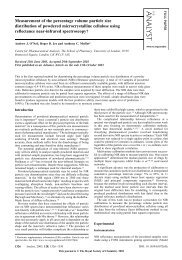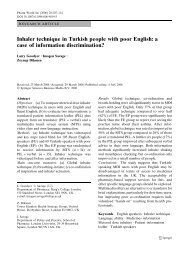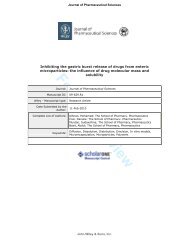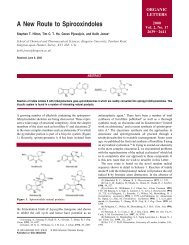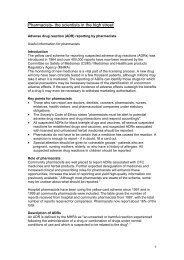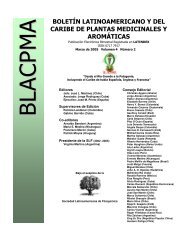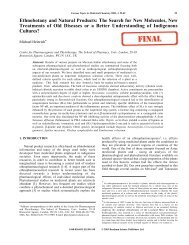SynArfGEF is a guanine nucleotide exchange ... - Pharmacy Eprints
SynArfGEF is a guanine nucleotide exchange ... - Pharmacy Eprints
SynArfGEF is a guanine nucleotide exchange ... - Pharmacy Eprints
You also want an ePaper? Increase the reach of your titles
YUMPU automatically turns print PDFs into web optimized ePapers that Google loves.
The synArfGEF-utrophin interaction was also independently verified using pull down assays.<br />
Cons<strong>is</strong>tently, GST-utrophin 2691-3429, 2691-3058 and GST-dystrophin 2937-3685 were capable<br />
of efficient pull down of full-length FLAG-synArfGEF from transfected COS-7 cell lysates, whereas<br />
neither GST-utrophin 2691-2843 nor GST alone was capable of mediating th<strong>is</strong> interaction (Fig. 6C).<br />
The synArfGEF-utrophin interaction was retained even when the salt concentration in the washing<br />
buffer was ra<strong>is</strong>ed to 300 mM, although the interaction between GST-utrophin 2691-3058 and<br />
synArfGEF was decreased (Fig. 6C). Furthermore, GST-utrophin 2691-3429 and GST-dystrophin<br />
2937-3685, but not GST alone, efficiently pulled down endogenous synArfGEF from brain extracts<br />
(Fig. 6D).<br />
The C-terminal 73 amino acids of synArfGEF used as bait contain a proline-rich sequence and<br />
type I PDZ-binding motif. The proline-rich domain <strong>is</strong> followed by a tyrosine residue (sequence<br />
PPPPY), which forms a known motif for binding to WW domains - the PY motif (Chen & Sudol<br />
1995, Rentschler et al. 1999) (Fig. 7A). Since the minimal region of utrophin required for robust<br />
interactions with synArfGEF contains a WW motif, we examined whether th<strong>is</strong> PY motif mediated<br />
the synArfGEF-utrophin interaction. Activation of reporter genes was observed when yeast was co-<br />
transformed with utrophin 2653-3429 and synArfGEF 1122-1194, ΔC3, 1122-1172, or 1141-1194,<br />
all of which contained the PY motif, although the β-galactosidase activity was dramatically reduced<br />
in the yeast transformed with utrophin 2653-3429 and synArfGEF 1122-1172 (Fig. 7B). The<br />
substitution of proline and tyrosine residues in the PY motif to alanine residues (PPPPY→PPAPA)<br />
d<strong>is</strong>rupted the interaction between synArfGEF and utrophin (Fig. 7A, B), suggesting that the PY<br />
motif in synArfGEF <strong>is</strong> critical for th<strong>is</strong> interaction.<br />
To examine whether synArfGEF and utrophin/dystrophin co-localize at synapses, cultured<br />
hippocampal neurons were prepared from rat embryos, maintained for 22 days and<br />
immunostained with antibodies against synArfGEF and dystrophin or utrophin. Dendritic<br />
synArfGEF puncta showed extensive colocalization with dystrophin (Fig. 8B-D). By contrast, anti-<br />
utrophin did not immunolabel hippocampal neurons (data not shown). Furthermore, synArfGEF-<br />
immunoreactive puncta were also associated with GABAAR α1 subunit and VGAT but not with<br />
PSD-95 (Fig. 8E-M). Taken together, these findings suggest that synArfGEF and dystrophin form a<br />
complex at inhibitory synapses of hippocampal neurons in vivo, mediated by PY-motif and WW<br />
domain interactions.<br />
Interaction of synArfGEF with S-SCAM/MAGI-2.<br />
In addition to utrophin, we also <strong>is</strong>olated several independent clones encoding the MAGI<br />
(membrane-associated guanylate kinase with inverted orientation) family, which contains six PDZ<br />
domains, two WW domains and one guanylate kinase domain and compr<strong>is</strong>es of three members,<br />
MAGI-1, S-SCAM (also called MAGI-2), and MAGI-3. S-SCAM was previously shown localize at<br />
inhibitory synapses and to act as a molecular bridge between the neurexin-neuroligin complex and<br />
the DGC via direct interactions with two adhesion molecules at inhibitory synapses, neuroligin-2



